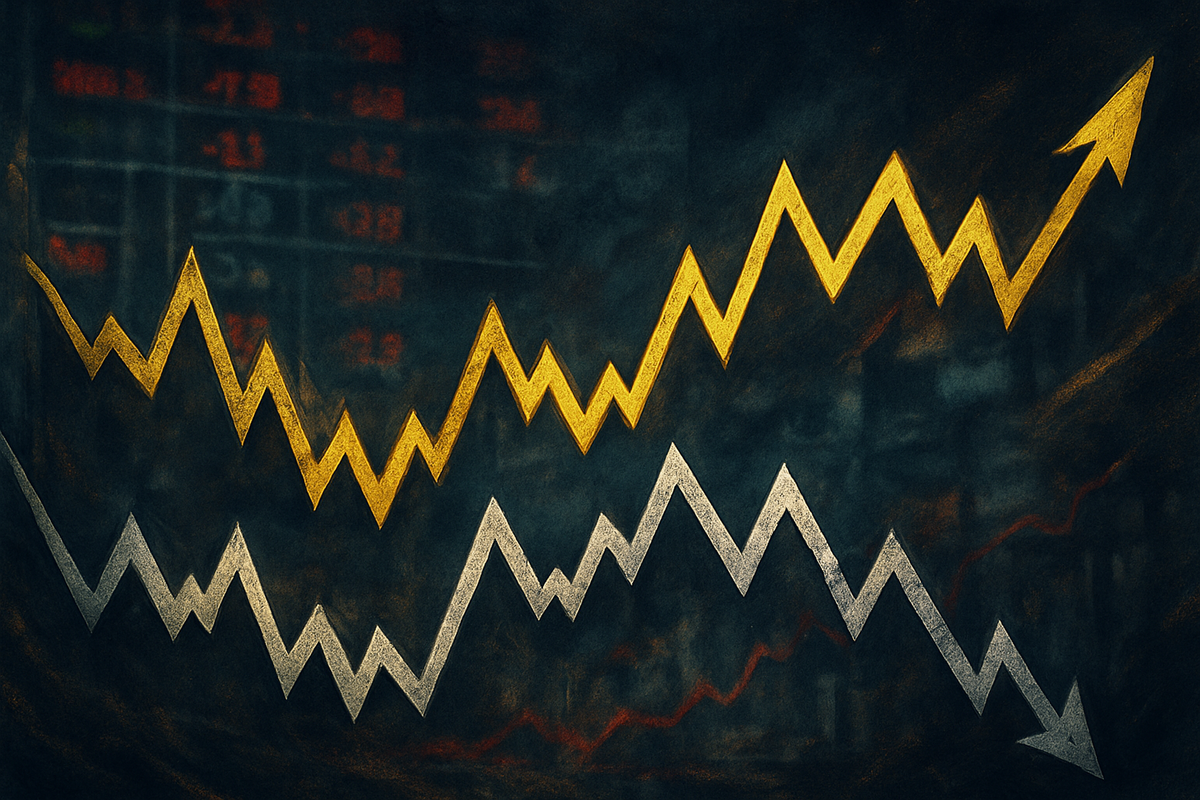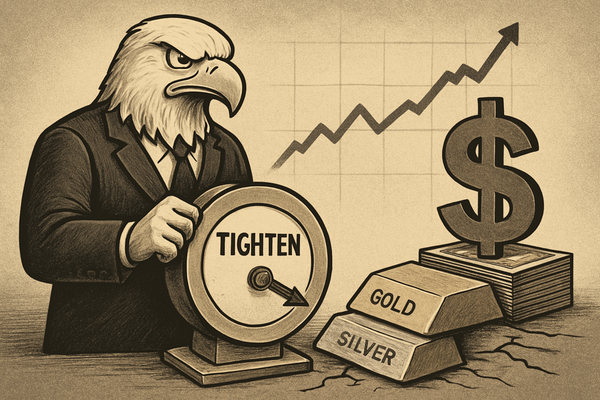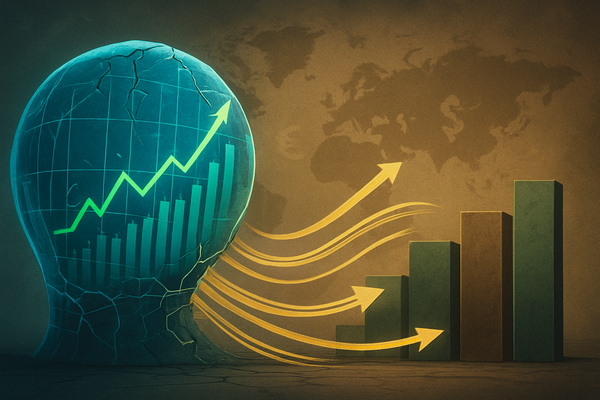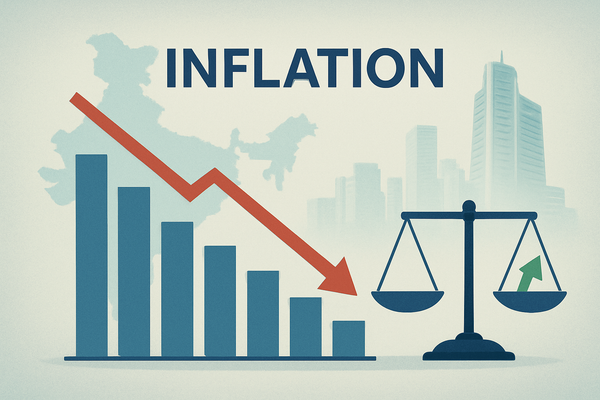Gold and Silver Markets Rocked by Extreme Intraday Volatility in Mid-November 2025

The precious metals sector has been gripped by an extraordinary surge in intraday volatility this week, with gold and silver prices experiencing dramatic swings across trading sessions in mid-November 2025. This unprecedented turbulence has sent shockwaves through global financial markets, leaving investors and analysts scrambling to understand the underlying drivers and anticipate the potential fallout for a sector often viewed as a safe haven. The immediate implications point to heightened uncertainty, a re-evaluation of risk appetites, and significant challenges for market participants ranging from institutional investors to individual traders.
The sudden and sharp price movements, characterized by rapid ascents and precipitous declines within a single trading day, underscore a fragile market sentiment susceptible to significant external pressures. This period of intense fluctuation could redefine investment strategies in commodities, particularly as market players grapple with the dual nature of precious metals as both inflation hedges and speculative assets in an increasingly unpredictable global economic landscape.
Unpacking the Turbulent Swings: A Week of Wild Rides
The week leading up to November 17, 2025, has been nothing short of a roller-coaster for gold and silver. On Monday, an initial surge saw gold (COMEX: GC=F) briefly touch a new multi-year high, fueled by escalating geopolitical tensions in Eastern Europe and renewed concerns over global inflation figures released over the weekend. However, this bullish momentum was abruptly halted mid-day by an unexpected hawkish statement from a major central bank, hinting at aggressive interest rate hikes to curb inflation. This triggered a sharp sell-off, with gold shedding nearly 3% from its intraday peak before partially recovering. Silver (COMEX: SI=F) mirrored gold's movements, albeit with even greater amplitude, experiencing a 5% swing from its high to low.
Tuesday brought further chaos as contradictory economic indicators emerged. A stronger-than-expected jobs report initially dampened safe-haven demand, pushing precious metals lower. Yet, this was quickly overshadowed by news of a significant cybersecurity breach impacting a major global financial institution, reigniting fears of systemic risk and sending investors back into the perceived safety of gold and silver. The whipsaw action continued, with both metals experiencing multiple percentage point reversals within hours, liquidating numerous leveraged positions across commodity exchanges.
By Wednesday, November 17, 2025, the market remained on edge, reacting violently to every piece of news. Large block trades observed in early Asian trading hours further exacerbated the volatility, suggesting significant institutional repositioning. The lack of a clear directional trend, combined with exceptionally high trading volumes, indicates a deeply divided market grappling with conflicting signals – on one hand, persistent inflation and geopolitical instability pushing for higher prices, and on the other, aggressive monetary policy and potential risk-off sentiment in broader equities markets creating downward pressure. Initial market reactions have been characterized by widespread stop-loss triggers, margin calls, and a general flight to liquidity, as traders attempt to navigate the treacherous conditions.
Corporate Fortunes in the Crosshairs: Winners and Losers
The extreme intraday volatility in gold and silver markets presents a double-edged sword for companies operating within the precious metals sector. Mining companies, particularly those with high operational leverage, are most susceptible to these rapid price swings. Producers like Barrick Gold Corporation (NYSE: GOLD) and Newmont Corporation (NYSE: NEM) might see their profitability forecasts drastically altered within days. While a sudden upward spike could temporarily boost revenues, sustained volatility makes hedging strategies complex and capital expenditure planning difficult. Companies with robust hedging programs in place for a portion of their production might be somewhat insulated, but those with significant unhedged exposure could face considerable earnings revisions.
Conversely, some entities could capitalize on the chaos. Proprietary trading firms and hedge funds specializing in high-frequency trading and algorithmic strategies are often well-positioned to profit from extreme intraday movements, provided they have sophisticated risk management systems. Additionally, certain financial institutions offering derivatives and options on precious metals might see increased trading volumes and fee generation, as investors seek to either hedge against or speculate on the volatility itself. ETFs tied to volatility indices or inverse ETFs could also see increased interest.
Silver miners, such as Wheaton Precious Metals Corp. (NYSE: WPM) and Pan American Silver Corp. (NASDAQ: PAAS), are likely to experience even greater swings in their stock prices due to silver's higher beta relative to gold. Their revenues are more acutely sensitive to price fluctuations. Furthermore, companies involved in the physical precious metals supply chain, including refiners and dealers, may face logistical challenges and increased inventory risk, but could also benefit from wider bid-ask spreads during periods of intense uncertainty. The ultimate impact on these companies will depend heavily on their individual financial health, their hedging strategies, and their ability to quickly adapt to rapidly changing market conditions.
Broader Implications and Historical Parallels
This episode of extreme intraday volatility in gold and silver markets is not an isolated event but rather fits into a broader trend of heightened uncertainty across global financial landscapes. It underscores the ongoing struggle between inflationary pressures, driven by supply chain disruptions and expansionary fiscal policies, and the tightening monetary policies being implemented by central banks worldwide to combat rising prices. Precious metals, traditionally seen as a hedge against inflation and economic instability, are caught in this tug-of-war, leading to erratic price action as market participants recalibrate their expectations.
The ripple effects extend beyond the immediate precious metals sector. Such volatility can spill over into other commodity markets, as investors rotate capital in search of stability or higher returns. It could also influence currency markets, with the U.S. dollar potentially strengthening as a safe haven during periods of global financial stress, thereby putting further pressure on dollar-denominated gold and silver. Regulatory bodies may also scrutinize the trading mechanisms and transparency of commodity markets more closely, especially if the volatility is linked to speculative excesses or market manipulation.
Historically, periods of extreme precious metals volatility often coincide with significant global events. The 2008 financial crisis and the early stages of the COVID-19 pandemic in 2020 saw similar, albeit less frequent, sharp intraday swings as investors reacted to unprecedented economic and health crises. The current situation, however, appears to be driven by a confluence of persistent inflation, geopolitical instability, and aggressive monetary policy, creating a unique and complex environment that challenges traditional safe-haven narratives. The speed and magnitude of these current swings suggest a more interconnected and algorithm-driven market, where reactions are instantaneous and often amplified.
What Comes Next: Navigating the Uncharted Waters
In the short term, markets should brace for continued volatility in gold and silver. The underlying drivers—geopolitical tensions, inflation concerns, and central bank actions—are unlikely to dissipate overnight. Investors can expect further rapid price discovery as new information emerges and market participants adjust their positions. This environment will likely favor agile traders with robust risk management frameworks, while long-term investors may need to reconsider their entry and exit points, potentially opting for dollar-cost averaging strategies to mitigate the impact of price swings.
Looking further ahead, this period of turbulence could prompt strategic pivots across the precious metals industry. Mining companies might accelerate efforts to reduce operational costs, optimize capital allocation, and potentially increase hedging activities to stabilize future revenues. Investment funds may re-evaluate their exposure to precious metals, perhaps favoring physical holdings over highly leveraged derivatives, or diversifying into other inflation-resistant assets. Regulatory bodies might also introduce new measures aimed at curbing excessive speculation or enhancing market transparency, although such changes typically take time to implement.
Market opportunities may emerge for contrarian investors willing to buy during sharp dips, anticipating a eventual rebound once the current uncertainty subsides. Conversely, challenges will persist for those reliant on stable, predictable price movements. Potential scenarios range from a continued period of high volatility, with prices oscillating within a broad range, to a decisive breakout in either direction once a dominant narrative takes hold—be it runaway inflation or a global economic slowdown necessitating a flight to quality. The key will be discerning which fundamental drivers ultimately gain precedence.
Comprehensive Wrap-Up: A New Era for Precious Metals
The extreme intraday volatility observed in gold and silver markets in mid-November 2025 marks a significant moment for the precious metals sector. It underscores the complex interplay of macroeconomic forces, geopolitical risks, and evolving monetary policies that are shaping asset valuations globally. The key takeaway is that gold and silver, while still retaining their safe-haven appeal, are no longer immune to the rapid and dramatic price movements seen in more speculative assets, especially in an era of high-frequency trading and interconnected global markets.
Moving forward, the market will likely remain highly sensitive to incoming data, particularly inflation reports, central bank pronouncements, and geopolitical developments. Investors should exercise extreme caution, prioritize diversification, and ensure their risk exposure aligns with their overall financial objectives. The lasting impact of this period of turbulence could be a fundamental shift in how precious metals are perceived and traded, moving away from a purely stable store of value to a more dynamic, albeit volatile, component of a diversified portfolio. What investors should watch for in the coming months are signs of stabilization in the macroeconomic environment, clearer guidance from central banks, and any de-escalation of geopolitical tensions, all of which could provide a much-needed anchor for gold and silver prices.
This content is intended for informational purposes only and is not financial advice



